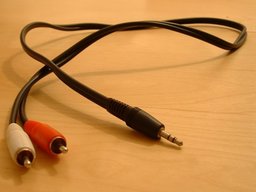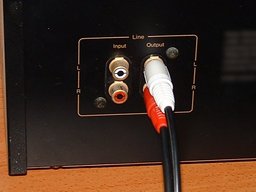How to connect your equipment
From Audacity Manual
Connecting your equipment
In general, you need to run an appropriate cable from an "out" jack on the external device (for example a tape deck, or an amplifier or receiver connected to a turntable) to the line-in port of the computer. You should not connect a standard turntable directly to a computer - see Special note on connecting a standalone turntable below. A typical cable you might use is a stereo mini-jack (3.5mm) to RCA cable.
If your device does not have RCA out, the headphone jack is a good "out" jack to choose, since it will allow you to adjust the output level of the source device. If you choose this approach, the most typical setup is to use a cable with a 1/8 inch (3.5 mm) stereo jack at one end (for connecting to the device's headphone jack), and an identical 1/8 inch stereo jack on the other end (for connecting to the line-in socket on your computer). If the device you are recording from has a 1/4 inch (6.3 mm) headphone jack, you will need to get a 1/4 to 1/8 inch adapter. Such an adapter is often included free with most new headphones, or can be purchased separately at any electronics store.
Some professionals with high-grade equipment would prefer to use the source device's "aux out", "tape out", "line-out" or "record" output (if so equipped), since that approach bypasses an unnecessary stage of (possibly low-quality) amplification, and standardizes the signal at a fixed (non-adjustable) level of approximately 1 - 1.5 volts, resulting in a higher quality recording. If you choose this approach, you will need a cable that has dual RCA red/white plugs at one end (for connecting to the "aux out", "tape out" or "record" jack of the device) and a stereophonic 1/8 inch (3.5 mm) plug at the other end (for connecting to your computer's line-in port).
Here is a typical cable you might use (a stereo mini-jack to RCA cable):
The RCA end might connect to the output jacks in the back of your cassette player:
The stereo-mini end should be connected to your computer's stereo line-in jack, usually found on the back of desktop machines. The line-in is normally colored blue, but check your computer manual.
You should not generally connect to the microphone (red) port of the computer.
- It will excessively amplify the stronger line-level signals produced by a tape deck or receiver/amplifier. This could lead to damage to the port or to your sound device.
- A microphone port is typically monophonic. If the port is monophonic, then even if you connect a stereo input to it and set Audacity to record in stereo, you will only record "dual mono" which has the same content in left and right.
The are only a few exceptions where you should connect to a computer microphone input:
- On some personal recorders, connecting from a low power minijack intended for connection to the microphone input of a recorder;
- On some Macs, or some Windows laptops or desktops, connecting to a "switchable" port which can be toggled to line-level stereo. Check your computer manual to see if there is a switch on the computer itself or in the sound card control panel. On a few laptops the line-level source is called "mix" or "stereo mix", but on most machines "stereo mix" will only record computer playback.
- On recent Windows laptops, notebooks or netbooks, there may be a "compliant" single port which will tolerate line level input and may provide stereo input. Even if stereo, the quality may not be as high as that of a dedicated line-in port.
Always try line-level input first, and only use a microphone input if you cannot otherwise get adequate recording volume. You can buy modestly priced, decent quality USB interfaces with line level stereo input if needs be.
If there is no way to record at line-level, add a line-in by adding a sound card or interface that connects to the computer via USB. Examples of recommendable devices:
- Griffin iMic (standard 1/8 inch input)
- Behringer UCA202 (left and right RCA inputs/outputs)
- Roland Duo Capture UA-11 (jack 1/8" & 1/4" inputs and 1/8" mini-jack output)
Special note on connecting a tape deck
If you wish to record from an audio cassette or a reel-to-reel tape deck, you can connect that deck directly to your computer without the need for any external amplifier or receiver. Simply connect the deck's "line-out" RCA jacks to your computer's "line in" jack, using a cable described above. You can also connect to the headphones out jack of an integrated cassette deck or to that of an amplifier connected to the tape deck. If you do this (or if the "line-out" volume of your deck is adjustable), it's best to set that level quite close to its maximum, and adjust the recording level using Audacity's input volume slider (see below). This helps keep the inherent tape noise to a minimum in the signal sent to Audacity. If the cassette you are playing has been encoded with Dolby ® as denoted by the Dolby Double-D symbol, then you must enable Dolby playback on your tape deck, or the recording of the tape will sound over-bright.
Special note on connecting a standalone turntable
If you have a standalone turntable, you must not connect it directly to your computer. Instead, you must connect it to an amplifier or receiver with a "phono" or turntable input, or to a phono pre-amplifier - and then record from the amplifier's "line out" or "tape out" jacks. This is for two reasons: (1) the audio signals produced by a phono cartridge are too weak to record directly, and (2) most records manufactured from the 1950s onwards were produced with a standard type of equalization called "RIAA", which emphasizes high frequencies and de-emphasizes (reduces) low frequencies. If left uncorrected, this will result in a recording that sounds very "tinny". All amplifiers containing a "phono" stage will both boost the signal to line-level so it's suitable for input into a tape deck or a computer, and will reverse the RIAA equalization so that the records sound "normal" again. If you have an integrated "stack system" or "entertainment center" into which you plug your speakers, your record deck is already connected to a suitable amplifier.
If you have a standalone turntable but no amplifier or pre-amp, you may want to consider the Behringer UFO202 or the ART USBPhonoPlus. These devices contain a built-in phono pre-amp and connect to your computer through a USB port. They can also be used to connect line level devices such as a cassette deck.
Special note on connecting a USB turntable
A USB turntable is a relatively new kind of turntable which is designed to connect directly to your computer's USB port. The concerns noted in the 'standalone turntable' section above do not apply here, as the necessary pre-amplification and RIAA equalization are already built into the USB turntable. There are some special playback and recording device settings you need to observe when using USB turntables - see our Wiki article on recording with USB turntables
Special note on connecting a MiniDisc player
Some users find that the line-level output of MiniDisc players is too strong for recording on a computer and causes distortion, since its level is not adjustable. If you are encountering this problem, try connecting your cable to the player's headphone jack instead. Since the strength of the headphone signal is easily adjustable, you can then reduce the signal level sent to the PC. On most players, this means using the same shared line out/headphones out socket/jack, but choosing the headphones out option in the player's "Sound Out" Preferences menu.
If you have a digital sound card, connect from digital out of the MiniDisc player to the S/PDIF input of the sound card.


